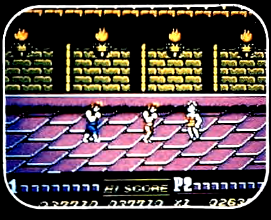Double Dragon II: The Revenge (NES)
| Double Dragon II: The Revenge |
|---|
|
Developer: Technos Japan
|
The Lee twins put their differences aside to take on a far deadlier foe, who quickly makes things that much more personal. This port of Double Dragon's sequel implemented the co-op feature that was inexplicably missing from the first NES game, as well as some funnier-than-intended cutscenes. G - R - A - S - P !
Contents
Sub-Pages
| Prototype Info |
Debug Features
There is a common debug feature in a couple of Technos games. Usually, all debug code is controlled by a memory flag, hardwritten at the end of the ROM at address $FFF6 in M6502 CPU address space. Various bits of this variable enable or disable various debug features.
Sample Version
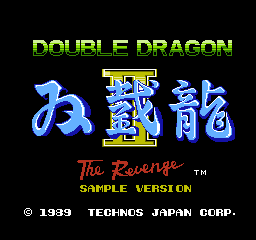
Bit 7 of the debug variable (to set it, use the Game Genie code EKNYVYAA) switches between normal and "SAMPLE VERSION", which enables some debug features. During the game, hold the Select button on Controller 1, then press one of the following buttons:
|
Free Walk
Bit 5 of the debug variable (to set it, use the Game Genie code AXNYVYAA) enables "Free Walk" mode, which allows you to walk to any part of a level instantly.
Unused Graphics
There are three different sprites for Marian, who appears just before the final battle in Mission 9. The first one on the left is the one that is used in the game while the other two are unused.
The manual for Double Dragon III: The Sacred Stones, which features a plot summary of the second game, uses a screenshot from an early version of the game in which one of Marian's unused frames is used. The palette also appears to be different from the one used in the final game.
Unused Text


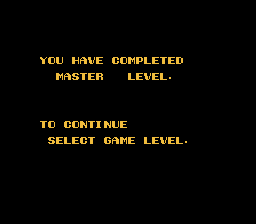
There are unused text strings in all versions of the game for what appears to be early versions of the ending messages that you'll get when you complete the game on one of the lower difficulty settings in the non-Japanese versions. Apparently the WARRIOR difficulty was originally called NOVICE. There also appears to be a message for when completing the game on SUPREME MASTER (originally called simply MASTER), even though the final version of the game contains no similar message and simply plays the ending sequence. These can only be viewed during debugging.
Regional Differences
Title Screen
| Japan | International |
|---|---|
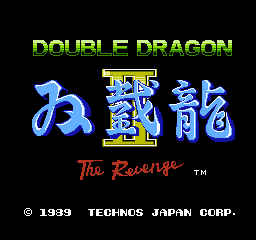 |
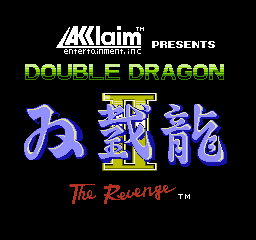 |
"Acclaim presents" was added to the top of the US and European versions' title screen, causing the logo itself to be moved a bit lower and the single Copyright line removed.
Copyright Screen
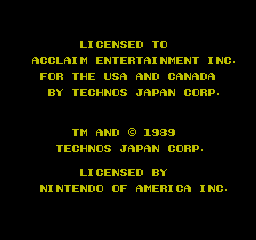
All the Copyright information has been moved to a different screen in the international versions, which is displayed just before going into the main menu.
Main Menu
| Japan | International |
|---|---|
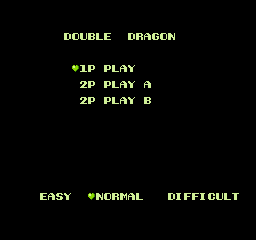 |
 |
The difficulty settings are given the much fancier names of PRACTICE, WARRIOR, and SUPREME MASTER in the international versions. Whereas in the Japanese version the choices are EASY, NORMAL, and DIFFICULT. The difficulty settings are also aligned horizontally in the Japanese version, allowing the player to move the cursor with the D-Pad by pressing Left or Right, whereas in the US/EU versions this can only be done with Select. US/EU versions also have the full title of the game on top, whereas the Japanese version simply says "DOUBLE DRAGON".
HUD
| Japan | International |
|---|---|
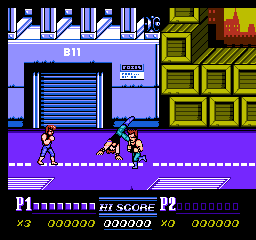 |
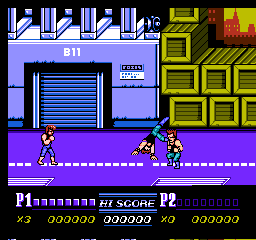 |
The HUD is four lines higher in the international versions compared to the Japanese version, partially obscuring some of the scenery.
Difficulty Differences
- The Japanese version allows the player to go through all nine stages on any difficulty setting, whereas the international versions restricts the game's length on the lower settings: PRACTICE ends the game on Mission 3, while WARRIOR ends on Mission 8, leaving Mission 9 accessible only on SUPREME MASTER.
- Continues are available by default in the Japanese version, whereas the international versions require the player to enter a cheat code at the GAME OVER screen that changes after every third stage. After choosing to continue, the player will be taken back to the main menu and will be allowed to change the number of players and difficulty setting before resuming at the last stage they left off. The length restriction will still be in effect after entering the Continue cheat. This means that if the player lowers the difficulty level to PRACTICE on Mission 4 or above, the player will be warped back to Mission 3 instead. Likewise, lowering the setting to WARRIOR on Mission 9 will cause the player to continue the game on Mission 8 instead.
- Enemies seem to be more aggressive and have more health points in the Japanese version's DIFFICULT setting than they do in the international versions' equivalent setting of SUPREME MASTER.
| Easy | Normal | Difficult |
|---|---|---|
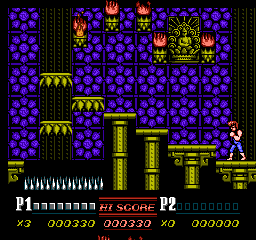
|
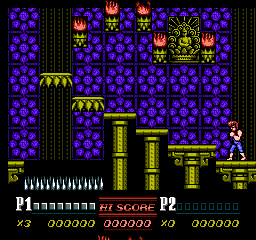
|

|
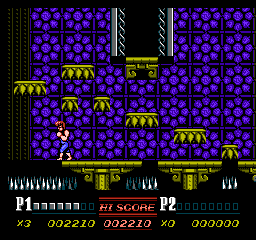
|
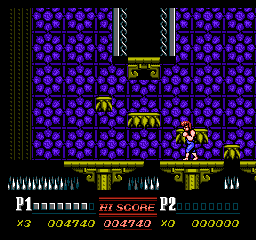
|
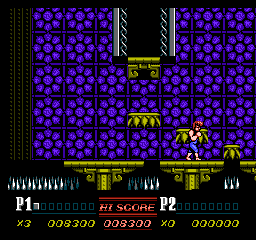
|
- In the Japanese version, the disappearing platforms in Mission 6 will have different patterns depending on the difficulty settings: on EASY, all the platforms will appear at the same time; on NORMAL, only two platforms appear at a time; and on DIFFICULT, only one platform appears at a time. In the international versions, the disappearing platforms always have the same pattern (one platform at a time), regardless of whether the game is set on WARRIOR or SUPREME MASTER. Normally, Mission 6 is unavailable on PRACTICE; however, if you cheat to access Mission 6 on that difficulty level, no platforms will appear, making the stage impossible to clear.
Cutscenes
The story sequences before each stage were originally written in English during the development of the game. In order to make room for the hiragana and katakana font sets, the majority of the images were rearranged within the CHR and reduced in size for the Japanese ROM, resulting in some (mostly subtle) differences between versions of the game. Mouseover for translations.
Mission 1
| Japan | International |
|---|---|
 |
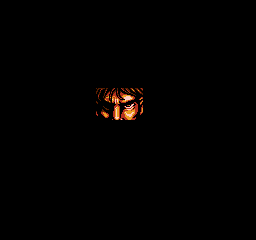 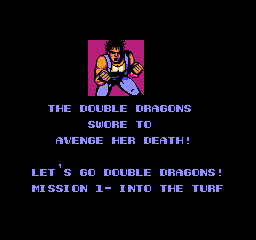 |
The final image in the opening cutscene in the international versions is a shot of Billy Lee posing and yelling dramatically. This image is missing completely in the Japanese version and instead, the opening ends with the image that comes before that, which is a closeup of Billy's eyes, but the image is much wider, showing his temples.
Mission 2
| Japan | International |
|---|---|
 |
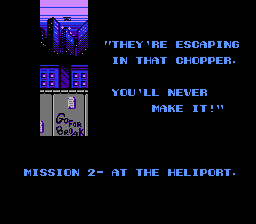 |
The international versions have an extra blue line to the skyline above the helicopter and lack the random gray tile at the upper left corner of the image that is in the Japanese version.
Mission 3
| Japan | International |
|---|---|
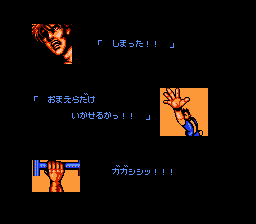 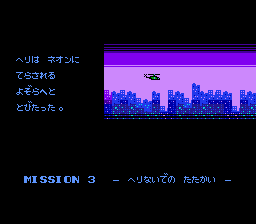 |
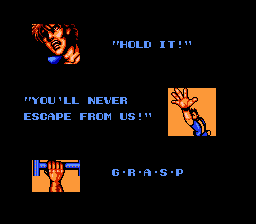 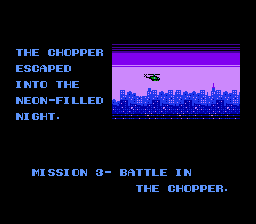 |
The closeup of Billy on the first screen has more details in the international versions (note the added hair and jacket on his shoulder) and a couple of pixels on the ladder shown on the third image are miscolored in the Japanese version. The image of the helicopter flying over the city on the second screen is wider in the Japanese version but has fewer building variations (note the Empire State Building-like structure in the international versions, which is missing in the Japanese version).
Mission 4
| Japan | International |
|---|---|
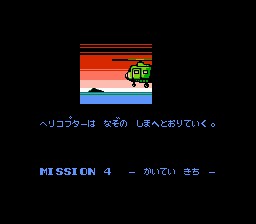 |
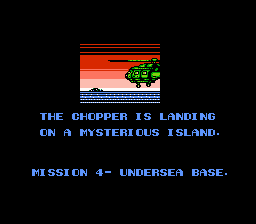 |
The island, sea, and helicopter have more details in the international versions.
Mission 5
| Japan | International |
|---|---|
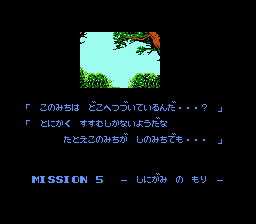 |
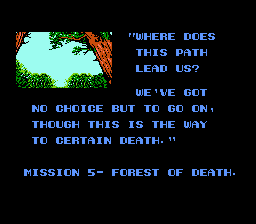 |
The image is a bit wider in the international versions, adding extra details to the trees on the left and right sides.
Mission 6
| Japan | International |
|---|---|
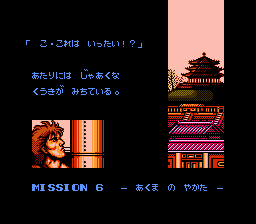 |
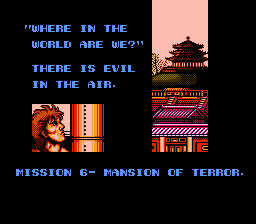 |
The roof above the main gate is colored differently and some of the tiny columns in the middle portion of the temple are uneven in the Japanese version.
Mission 7
| Japan | International |
|---|---|
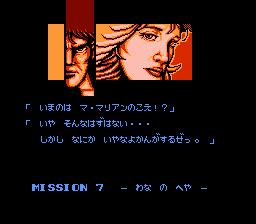 |
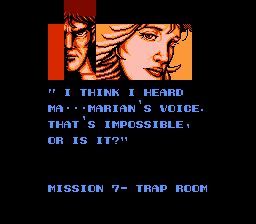 |
The closeup of Billy's face is slightly wider in the international versions and the background behind Marian has been recolored.
Mission 8
| Japan | International |
|---|---|
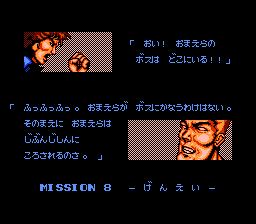 |
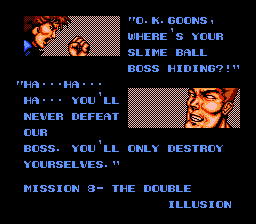 |
There's extra bits of flesh-colored pixels next to Billy's mouth in the international versions and Abore's hair was changed from blond to brown.
Mission 9
| Japan | International |
|---|---|
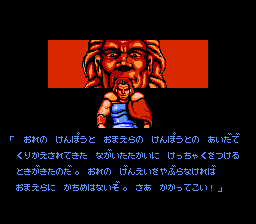 |
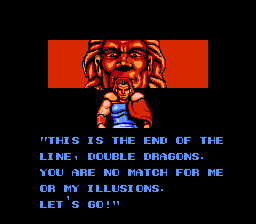 |
An extra pixel tile next to the Mysterious Warrior's right shoulder (on our left side) is missing in the Japanese version.
Regional Leftovers
The Japanese and international versions of the game contain a lot of disabled code leftovers from the other regional version. Although it is not possible to completely switch either version to another language mode, it is possible to switch between the two different sets of features in various places to change game behavior between Japanese and international modes. Typically, the code pattern for such disabled code branches is A9 XX F0 which translates to the instructions "LDA #$XX" and "BEQ $", which means that the branch will always happen if XX is zero or always not happen in other cases. For the Japanese version, XX is all zeroes, while for the international versions XX is $80. Since you can only disable some of the screens and modes in the international versions with these codes, it's not very interesting. However, you can re-enable some things in the Japanese version that are different from the final international versions.
Different Title Menu
| Old Title | Final Title |
|---|---|
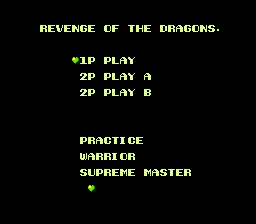 |
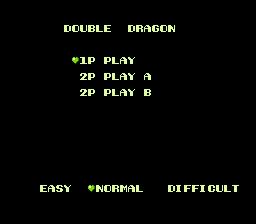 |
The Game Genie code PENNGLAA re-enables an earlier version of the international title menu on the Japanese version of the game. It seems that the title for the game was going to be "Revenge of the Dragons" at some point. The Game Genie code AANNAIEA-AENNGLEA re-enables the Japanese version of the title menu for the international versions of the game.
Glitched Copyright Screen
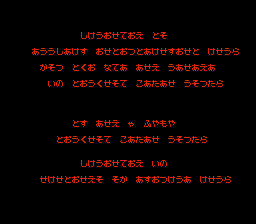
The Game Genie code PAKNYAAA re-enables the copyright screen from international versions of the game, but because of incorrect CHR bank settings, the text displayed becomes Japanese gibberish. You can decipher what was meant to be written by simply replacing the kana for the corresponding Roman character in alphabetical order (e.g. あううしあけす=ACCLAIM). Also, the text palette is different from the one in the final international versions.
Difficulty Limits
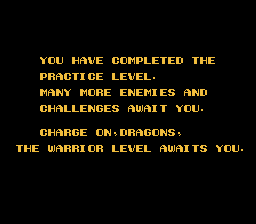
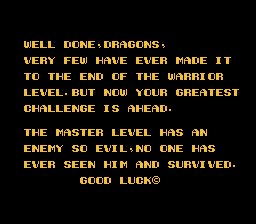
The Game Genie code PEKOYGAA re-enables the difficulty limits in the Japanese version. Messages for both difficulties are mostly similar to the ones in the final international versions, with two differences: 1) they call you "DRAGONS", instead of "DOUBLE DRAGONS"; and 2) the exclamation mark next to the phrase "GOOD LUCK" (!) has been replaced with a Copyright symbol (©).
- Pages missing developer references
- Games developed by Technos Japan
- Pages missing publisher references
- Games published by Technos Japan
- Games published by Acclaim Entertainment
- NES games
- Pages missing date references
- Games released in 1989
- Games released in December
- Games released on December 22
- Games with unused graphics
- Games with unused text
- Games with debugging functions
- Games with regional differences
- Double Dragon series
Cleanup > Pages missing date references
Cleanup > Pages missing developer references
Cleanup > Pages missing publisher references
Games > Games by content > Games with debugging functions
Games > Games by content > Games with regional differences
Games > Games by content > Games with unused graphics
Games > Games by content > Games with unused text
Games > Games by developer > Games developed by Technos Japan
Games > Games by platform
Games > Games by publisher > Games published by Technos Japan
Games > Games by publisher > Games published by Throwback Entertainment > Games published by Acclaim Entertainment
Games > Games by release date > Games released in 1989
Games > Games by release date > Games released in December
Games > Games by release date > Games released in December > Games released on December 22
Games > Games by series > Double Dragon series
The Cutting Room Floor > Unimportant Awards > NES games
